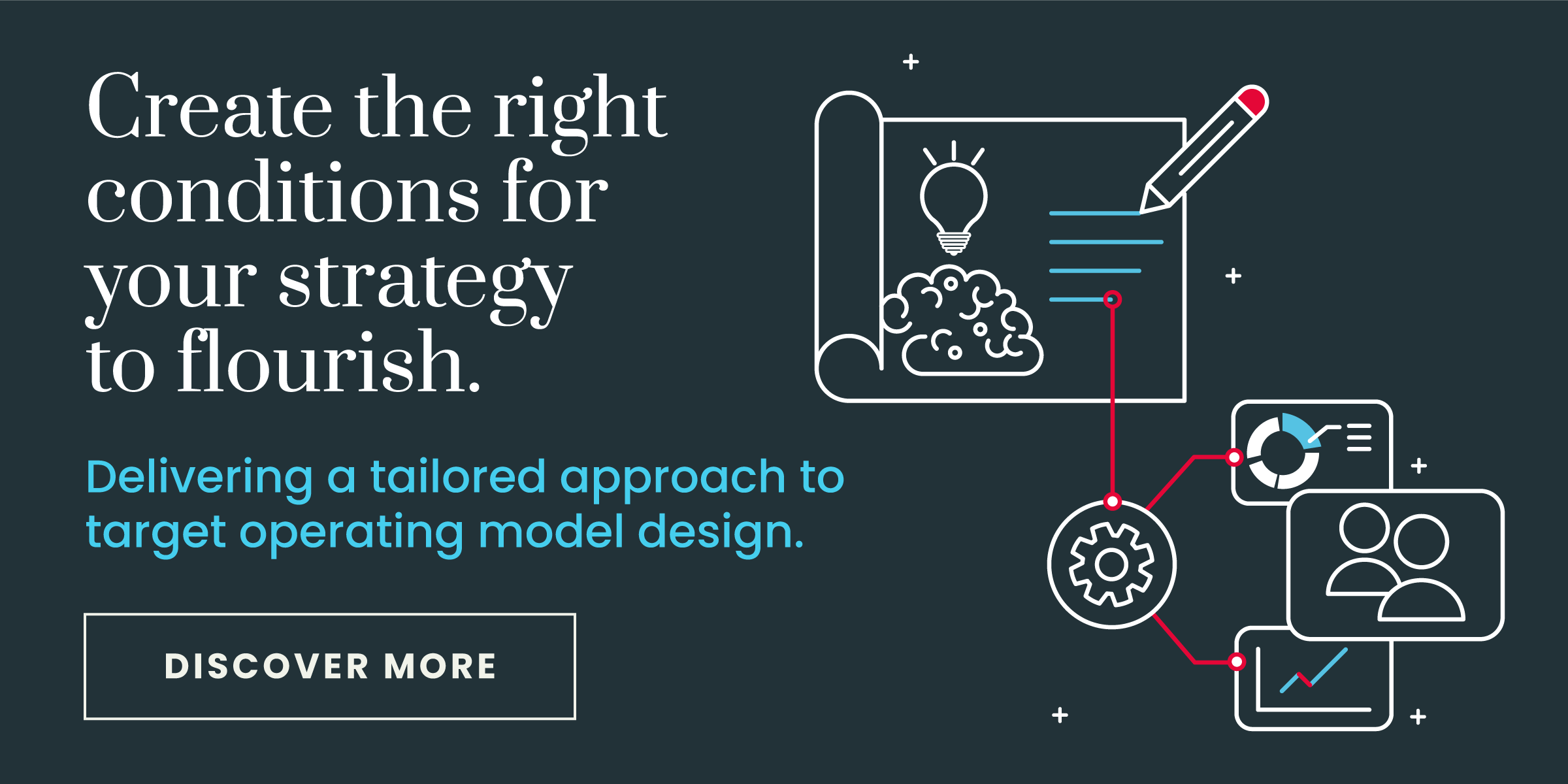Understanding the importance of Target Operating Model
When your existing operating model doesn't line up with your strategy, it becomes difficult to enact the changes you want to see within your organisation. Determining your desired target operating model is a means of preparing your business for growth. It's an organisational blueprint with critical processes mapped and optimised, and a clear view of functional capability requirements.

Straddling the divide between strategy development and strategy implementation, there is a bridge that enables your organisation to cross effectively from vision into execution. This enabler is your Target Operating Model – in essence, the resources, capabilities, and approaches that make up your ways of working.
The nature of a Target Operating Model is that it is not how your business is run now (your current operating model), but a blueprint for how it should be run in the future to meet those new strategic objectives. It’s a means of preparing your business for growth, but also to build in the agility and resilience to cope with changes in the landscape along the way.
> RELATED ARTICLE: Common points of failure to avoid when implementing your strategy
What is a Target Operating Model?
A Target Operating Model describes how a business should be organised to deliver its goals. It breaks down the people, processes and tools required to support the strategic vision, without which the strategy could not be executed.
Why is a Target Operating Model important?
If strategy is a roadmap, and implementation is a journey, you could think of Target Operating Model (TOM) as a combination of infrastructure and itinerary. A good target operating model can make the difference between a comfortable flight direct from London to Singapore, or taking a 'Race Across the World' style overland adventure – slower and far riskier.
When your operating model doesn’t line up with your strategy TOM, you will find it difficult to enact the changes you want to see within your organisation. Processes that should be collaborating may fall out of alignment. Everyone might be busy, but progress may be slow. Difficult workflows make for unhappy workers. If they lose faith in the strategic vision, you’ll have a battle on your hands trying to win it back.
A less-than-optimal operating model has significant impacts on a business:
- Initiatives take a long time to be delivered with the operating model acting as a barrier to progress rather than an enabler.
- Resources are spent on non-priority activities that either do not contribute to strategic goals or could be removed with minimal impact.
- Initiatives are needlessly duplicated across the business.
- The significant energy required to maintain day-to-day activities prevents focus on initiatives.
But when your TOM is built to meet the needs of your strategy, you can expect to find:
- A greater focus on strategic initiatives, leading to accelerated progress towards ambitions and goals.
- The required capabilities for growth hard-wired into the right parts of the organisation.
- Less time wasted on unnecessary activities, reducing costs, and increasing profitability.
- Services or products are delivered more efficiently, leading to improved customer experience and satisfaction.
- Greater agility to respond swiftly to market changes, customer demands, and emerging technologies.
- Employees are empowered to make decisions within their scope leading to higher engagement and job satisfaction.
- Teams can collaborate efficiently without unnecessary barriers.
All together plainer sailing, leading to accelerated growth, enhanced efficiency, greater customer centricity, increased agility, and empowered teams.
What’s in a Target Operating Model?
If the right target operating model is a critical part of creating the conditions for strategic success, what does a winning TOM include?
Imagine you’re a football manager, trying to win the Premier League. What are the key ingredients to a winning team?
- Structures and accountabilities – your formation, how many attackers vs defenders you plan to field, which positions you are counting on for creativity, which for stability, how those things might change over the course of the season.
- Processes and systems – your tactics, the set piece moves you want your player to deploy, how they should play together, which positions need to work together.
- People and capabilities – have you got the players you need, have they got the skills they need? You might need a new player in a certain position as nobody you currently have is able to play the role you need them to. You might need to focus your coaches on developing a certain capability in another player for them to be able to put a certain tactic into practice.
Successful managers spend their pre-seasons addressing all these things, before a ball has even been kicked, they are preparing the conditions for success.
A TOM works in the same way. It’s developed from the strategic priorities, shaped by external market context and trends, and built out until you have an organisational blueprint, critical processes mapped and optimised, and a clear view of functional capability requirements.
Designing a Target Operating Model
There’s a conventional view of Target Operating Model projects; one with lots of baggage!
Traditionally, TOM projects involve a very detailed, exhaustive audit of all the activities and processes involved in running business. This leads to lengthy, expensive projects where consultants attempt to map the entire business, its structures and its processes and produce a huge amount of output before redesigning everything from the bottom up. These projects often don’t involve people outside of the senior team in designing the solution, which can create ill feeling within the business.
We take a more agile approach that helps to speed up the initial project stages and create less disruption in the business.
A top-down perspective, focused on the capabilities that a business needs to deliver its strategy, allows for quicker projects and less disruption to day-to-day operations. Engaging a broader group of senior leadership builds buy-in, turning potential detractors into advocates. A focus on pragmatism creates a model that can be recognised by the business of today, but delivers the capabilities needed for tomorrow; minimising the risk that an operational change overshadows the strategy it was designed to support.
There is undoubtably a time and a place for the full-blown TOM project, but it is not the only option. Faced with the prospect of months of onerous, highly introspective analysis many businesses shy away from looking at their operating model, leaving gaps in their ability to deliver their strategy.
By adopting a more agile approach, businesses need not fear TOM projects, they can be the most effective accelerator of strategic progress.
Putting the Target operating model to work
Take an illustrative example - a soft-drinks business with an existing model focused on wholesale supply to a single market, but seeking to expand both internationally and into direct supply. This business would need to significantly address the way they operate to successfully deliver their new strategy. New routes-to-markets, extended supply chain requirements, different commercial partnerships, an e-commerce solution, shopper marketing skills, additional consumer and customer insights needs are only some of the aspects that would stretch the existing model to breaking point.
These are examples of new structures, new talents, new processes, and new capabilities needed, all requiring strong leadership. It’s not possible to simply state: we’re going to start offering our brand to new customers in new markets. The operating model must be up to task.
For many businesses, articulating their operating model is a challenge. But as we’ve shown, the Target Operating Model underpins strategy at every turn, and should be designed with purpose to enable an organisation to achieve its goals.
> TALK TO US: Contact our team about how to create the right conditions for your strategy to flourish


